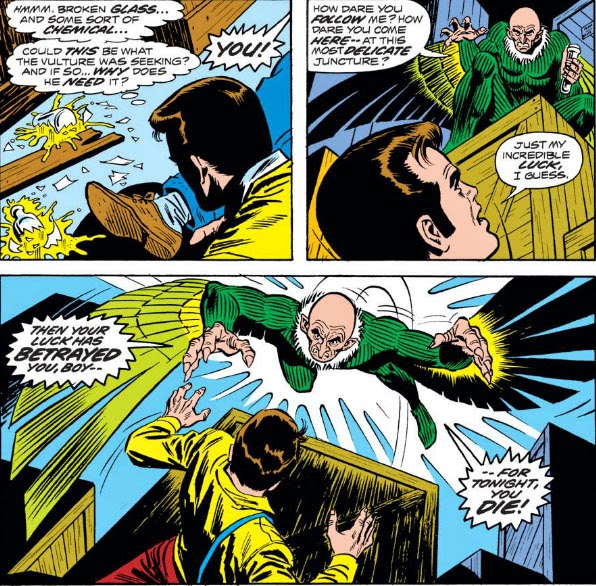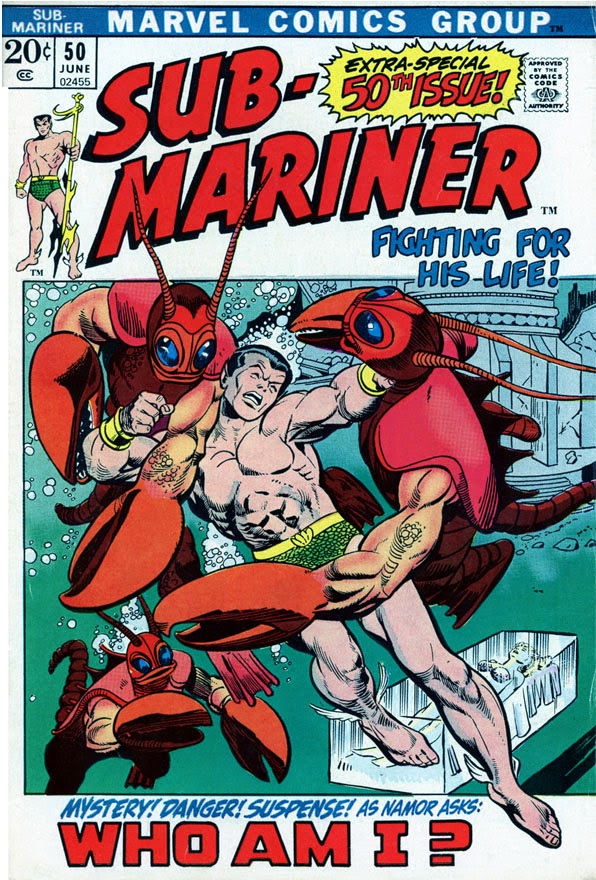Like many stories that Jack Kirby scripted for Marvel during his return to the company in the late 1970s, the story in
Captain America #198 is something of a mixed blessing. Kirby often had his heart in the right place when writing the dialog for the stories he would create, and that truly comes across as this story plays out--even though the thought of Kirby putting Cap into the middle of a
Love Story-themed issue and assuming the Oliver Barrett role must seem like an atrocious one. For what it's worth, Kirby only adapts certain elements of the film (including, of course, its eye-catching title), and crafts an interlude of sorts in his ongoing Madbomb arc--though an interlude very nicely woven into the urgency of the main story's hunt for the Madbomb's inventor.
You may be surprised at how well it all works. Even re-reading this issue a number of years after its initial publication, I kept remarking to myself on certain aspects to Kirby's style of storytelling: how well certain scenes were placed... how integral Kirby is making the Falcon both to his partnership with Cap and to the book itself... the interesting notion of a joint U.S. Army/SHIELD operation... the excellent use of shadow... how well it works to make Cap's "love interest" the daughter of the conspiracy guy they're trying to nab. And as for Cap's interaction with the woman he meets, I admit to steeling myself for what I thought was going to be a very awkwardly handled and excruciating set of scenes with the two of them, given Kirby's flowery prologue to the story on page one; but instead, I found myself sympathizing with Carol Harding, a terminally ill woman whose story might have come across quite maudlin without the Madbomb threat to take center stage and give it perspective.
Once the story ends, you can find yourself taking different meaning from Kirby's opening narrative and the signals you feel it's sending--particularly the way it seems to imply that the story you'll be reading is going to come to a grinding halt as this entire issue focuses on a romantic rendezvous for Cap:
Even Kirby seems to have had an afterthought, and inserted the blurb about the Falcon so that readers would know this story wouldn't be
all hearts and flowers. In fact, I'd say the "love story" (and you'll find even
that is misleading) only takes up about one-third of the issue. That's not to say that Cap and Carol don't have their moments--it's just that they won't require the string section you might be expecting.
The story begins where the prior issue left off--with Cap, Falc, and an Army task force mopping up the conspirator installation where the final Madbomb had been built. Unfortunately, the device itself escapes their grasp:
Following the hectic events of the past few issues, it's a lull that allows everyone to regroup and plan their next step. Fortunately, with time of the essence now that the conspirators are being actively hunted and could likely move up their timetable, a lead presents itself in the form of Mason Harding:
We then get some background on Harding, who is indeed involved in the conspiracy but who diligently tends to his bedridden daughter, Carol:
It's difficult to be certain from this scene, but we're given the impression from Harding's interaction with his "security" that he's seen his involvement in this situation spiral out of control, to the point of his daughter being possibly endangered during its final stages. He doesn't seem to us at first glance to be a man acting out of malice, but rather a man in over his head. That allows us to sympathize with both him as well as Carol--a woman who, regardless of whatever treatment her father is providing for her, has a dim outlook on her life.
Unknown to anyone at this estate, SHIELD agents have arrived with Cap and the Falcon, in order to make preparations for capturing Harding. But, as Cap enters the house to reconnoiter, he realizes that the discovery of Carol may hinder their plans to take the estate by force:
The notion that Carol might not recognize Captain America, of all people, is difficult to take at face value, unless she's been the most incredibly insulated bedridden adult patient in history. But Kirby's narrative does a fair job of glossing over something that must surely have struck some readers as odd; and it's fairly important that at this point in the story, Carol relate to Cap not as "Captain America," but as a stranger who elicits her trust and interest. It's asking a lot, with this man's unmistakable uniform and shield practically saluting in every panel--but, as the saying goes, we become lost in the moment:
It's a brief talk between the two, but it's probably enough of a development to make Cap realize that reconnaissance of the rest of the house has become moot, given Carol's presence and how any plans to raid the estate must be altered accordingly.
We can also see (and gratifyingly so, out of a sense of realism) that this is no "relationship" that has sprung up between the two in the span of only a few minutes, but simply Cap consoling this lonely woman and not alarming her as to the true nature of her "security men." And he extends that compassion for her by making her a part of the plan that's already formed in his mind to see to her safety, with Carol herself providing the key:
But when Cap departs, we see that the meeting has had a deeper effect on Carol. A fact Kirby has made sure to emphasize by maintaining his wistful narrative during their scenes together:
Later, at the beach, Cap meets up with the Falcon and lets him know his train of thought on a revised raid. These two panels really amount to no more than bringing the Falcon up to speed--but I wanted to point out the nice use of shadowing that Kirby applies to the Falcon's outline on the beach from overhead. I think it's such a cool way to transition to the meeting:
As Cap spells out the situation, it's obvious that Carol has had an effect on him--but, as he states later, it's more in the spirit of "repaying kindness with kindness." In addition, though, he seems to feel empathy toward her, an innocent caught up in a life-or-death conflict that shouldn't be an added burden to her in her current state:
And Carol indeed shows up--only this time, she meets the man behind the mask, who it seems has successfully removed her from harm's way. Though, again, we sense that they're not on the same page as far as their expectations are concerned:
We know from this issue's cover that, despite their getaway, Carol and Cap are in danger from gunfire. It's also been implied that the Falcon isn't going to be successful with any kind of rescue:
Yet it's only a bit of sensationalism we're seeing, and in a way it's reassuring that it's only a cover's sales pitch in play. Because so far, Kirby has handled this story deftly as it steadily unfolds toward its resolution--and when the Falcon indeed "does his action bit," it's nice to see this character shine, in a splendid scene which Cap doesn't even know is going down:
Again, Kirby is generous with his treatment of the Falcon--so when the raid on the estate begins, Falc is right in the thick of things with SHIELD's agents ("G-men," it seems, judging by Kirby's perception of their "uniforms"--with '50s hats, even).
Meanwhile, at a lazy campfire on the beach, Carol hears the noises coming from the estate, and wants to cut the day short in order to see if there's anything going on there. But Steve rightly assumes that the raid is now in progress, and manages to distract her:
Some ruffians with a ball have interrupted the quiet day for these two--and here, Kirby's predilection for past times becomes evident in one of his stories. Right down to the speech, the clothing, and, heaven help us, the handlebar moustache:
What are the odds that these gentlemen are going to be swayed by Steve's well-reasoned words? (You needn't take the time to calculate them.) What follows could be Kirby's humorous take on the old "beach bully kicking sand in the face" ads for Charles Atlas--only here, the victim is already more than a match for
all of the bullies:
Yes, finally--i.e., now that it's the right time in the story for it--Carol "makes the connection" between the parting words of one of the men and the true identity of her companion. And in coming clean, Steve seems to also feel the need to be as frank in describing his intentions as much as he means to be reassuring:
It also becomes clear to the reader at this point the actual nature of this "love story"--one-sided, perhaps, and surely platonic, but nonetheless a very caring bond formed between the two. And it seems to give Carol the resolve to trust Steve with handling one other aspect of her condition:
![]()
It's a scene which serves as the ending for the issue. I suppose for the purpose of the story, Kirby might have felt that it made sense to end on that note, and so abruptly. Clearly, Carol's revelation takes Steve by surprise, as he was unaware of the full extent of her illness. Throughout the story, Kirby has deliberately withheld disclosing any certainty of Carol's chances, one way or the other--a decision made easier by the fact that we're never told exactly what illness Carol is suffering from, nor the nature of the operation she's had to supposedly combat it. But Kirby at least gives us a measure of closure the following issue, where Carol receives confirmation of her father's illicit activities:
We also receive closure on the "love story" that really wasn't, something Carol has finally come to terms with but must still put behind her:
No, I don't know what Carol's "hater" reference in regard to Cap has to do with anything, either. Kirby made frequent attempts in his stories to name-drop contemporary terms in order to give the appearance of being up-to-speed on current cultural trends and references; but here, it throws a virtual bucket of cold water on the kind of ending he hoped to achieve to Carol's association with Cap. Perhaps she was simply trying to make the point that Cap wasn't the kind of person who held a grudge and who believed in second chances. As for Mason Harding, he holds
quite a grudge toward the "Elite" who used him, and steps up and does the right thing: providing Cap and SHIELD with the information they need to locate the devastating Madbomb.
![]() | Captain America #198
Script and Pencils: Jack Kirby
Inks: Frank Giacoia
Letterer: Gaspar Saladino |









































































































































































































































































































































